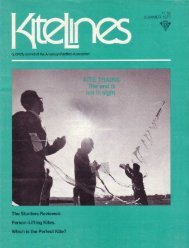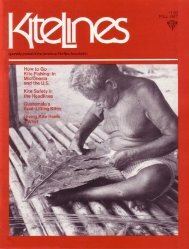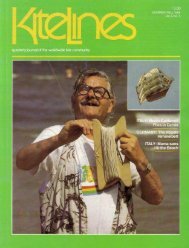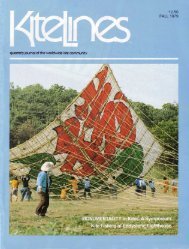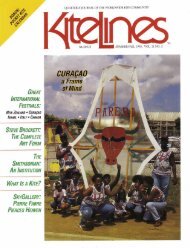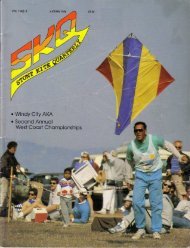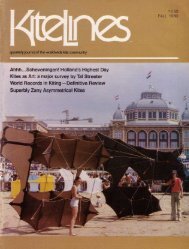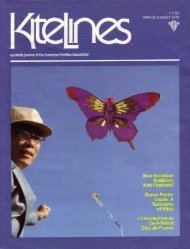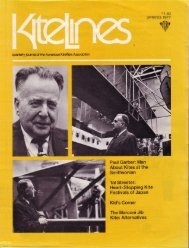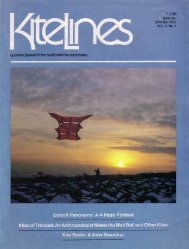Kite Lines - Vol.3 No. 1 - KiteLife
Kite Lines - Vol.3 No. 1 - KiteLife
Kite Lines - Vol.3 No. 1 - KiteLife
- No tags were found...
Create successful ePaper yourself
Turn your PDF publications into a flip-book with our unique Google optimized e-Paper software.
stacked in train one above the other . TheFlexifoils are laid out on shore-a twomanoperation in the competition-and"you'll either be pulled straightaway athigh speed, or-watch out for a devilishwind-you'll be straightaway yanked rightback up on the shore ." Day and Geoffreyhad been in constant practice for somemonths and were confident of winningthe 300 square foot class ; in time, theheavier classes as well. Andrew had beenworking on improved performance 'foils .(Six months later he was successful inincreasing pulling efficiency 40% with anew 10-foot span 'foil .)I looked up from the sidewalk-in disbeliefat this story-for a quick sidewaysglance at Ray . I hadn't really studied himat our first meeting in London a year earlier. Ray has long dark hair . He generallylooks up at the flying 'foils through darkaviator sunglasses. <strong>No</strong>w off, they'd beenhiding twinkling eyes and thick eyebrowswhich arch together over the nose . Hischeeks seem permanently dimpled in aquizzical, friendly smile . He's an EnglishJalbert, I thought, reminded of the wayJalbert throws you completely off balancewith talk of kites that do all kinds ofthings you never expected kites could (orperhaps should) do .Ray was born into a working classfamily in 1952 . His father is a stevedore .Left, friends and partners inthe invention of the Flexifoil :Ray Merry (left) andAndrew (Wilf) Jones .Below, 100 foot polyethylenetube, 18 inches diameter, flownin 1973, Newcastle-upon-Tyne .His mother died while he was still quiteyoung . Trained as an industrial designer,his natural bent is sculpture . Part of ourboulevard jaunt was spent in my trying tounderstand the conical sculptures Ray envisioned,suggested to him by the flyinglines of the stunting Flexifoils . He doesnot enjoy unrealized or partial solutionsto problems . "I don't know how you feel,but I'm not satisfied if things aren'tperfect ."The Partnership"Common to both Ray and me," Andrewtold me in one of our conversations, "wasthe influence of making things, the importanceof using our hands and fathomingthings out ."I've tried on several occasions toascertain our differences," he continued ."We just happen to be good reflectorswith each other's thoughts . Sometimes,of course, we drag each other down, butwe tend to gain momentum in conversationwith each other. The basic idea, awind-inflated wing, a primitive version ofthe production Flexifoil, came in a flash .We're frequently asked which of us is theprimary inventor . It's absolutely impossibleto determine . We're a single personas far as the 'foil goes ." The productionFlexifoil was several years away from thatlightning flash .They met in 1971 in their first year ofcollege study in the core design curriculumat Newcastle-upon-Tyne Polytechnic, alarge new college built in the late 60s twohundred miles north of London in<strong>No</strong>rthumberland . Both students hadopted for industrial design courses withan eye to future financial solvency, butboth found the more purely fine artscourses and faculty suited to their talents .It was a one-day fine arts sculptureproject which they tackled together thatled to the Flexifoil . The assignment hada bit of intentional ambiguity built into it .On a blackboard in a room sans teacherwere written several words . Students wereasked to choose one word and interpretthat in an object of their own making .They chose the word winding. They builta sort of wind vane which they hopedwould spin around in the wind .At our first talks in London, Ray recalledthat "<strong>No</strong>t much really came of that ."Andrew continued, "After trying avariety of forms, we arrived at bag shapes .We found a large polyethylene mattresscover bag . We put a steel ring in the openingand tethered an elastic line to that . Itwas all a bit haphazard, but we kept at it,making do with the materials available tous . About this time we thought aboutmaking the bag lift into the air . We weresurprised by the ease with which a verylarge bag would inflate and stay up withwind coming through a very small opening. We didn't know anything aboutinflated wings at that point, but not toolong into the project we were intriguedenough by the possibilities to do somelibrary research .""There was little to find out," Rayinterjected . "The only thing we came upwith were pictures of a U . S . Air Forceexperimental pressurized wing with athree-wheeled vehicle slung below ."They knew nothing of modern, lightweighthigh-density rip-stop nylon . Theyused cellophane tape and a primitive butadequate hot soldering iron and aluminumfoil technique to heat-weld polyethyleneplastic sheeting . Their first airfoil wingshape had a 14-inch span, eight-inch chorddepth . The second version was three feetsix inches by two feet . The airfoil wingform and gore building technique camedirectly from the balsa and tissue paperairplanes they had both enjoyed as ahobby. The small wings were still tetheredas a kind of kinetic sculpture . The thoughtthat they were working on a kite had not



